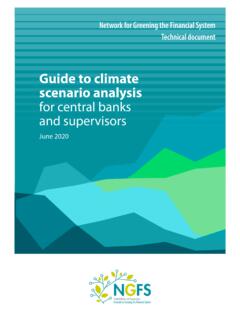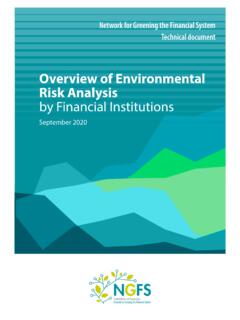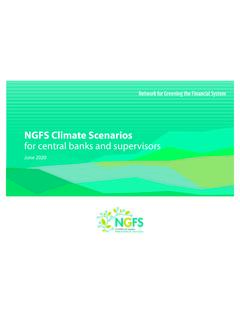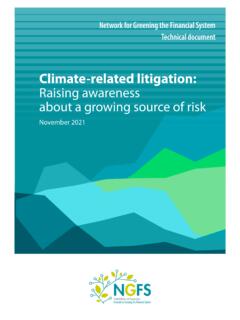Transcription of Guide on climate-related disclosure for central banks
1 Network for Greening the Financial System Technical documentGuide on climate -related disclosure for central banks December 2021 NGFS Technical documentDECEMBER 2021 This report has been coordinated by the NGFS Secretariat/Banque de France. For more details, go to and to the NGFS Twitter account @NGFS_, or contact the NGFS Secretariat REPORT2T he impacts of climate change on households, businesses, and the global economy are not the problem of future generations but our own. The significant increase in extreme weather events reminds us how urgently we need to transform our economies to reach climate neutrality. To foster this transformation, the financial system needs to mitigate climate -related risks and mobilise capital for green investments.
2 In this context, transparency about climate -related financial risks and opportunities is the first comprehensive NGFS report A call for action , published in April 2019 we emphasised the importance of a robust and internationally consistent disclosure framework. NGFS members also collectively pledged their support for the recommendations of the Task Force on climate -related Financial Disclosures (TCFD). We reiterated this commitment in November 2021 with the NGFS Glasgow how-to Guide delivers on our commitment to promote climate -related disclosures among central banks . Based on the recommendations of the TCFD, this Guide is an open invitation to all central banks NGFS members and beyond to lead by example by disclosing the climate -related risks and opportunities on their own balance sheets and relating to their physical operations.
3 climate -related disclosure by central banks should address key issues relating to governance, strategy, and risk hope this Guide will reinforce the momentum on climate -related disclosures, a cornerstone for greening the financial system. While this is a crucial first step, we will not stop here: we are committed to building on this report and the experience gathered by NGFS members to expand our guidance in the future while tackling upcoming challenges with equal of these challenges is the loss of biodiversity. We must not forget how much of our well-being we owe to nature. However, aggravated by climate change, biodiversity is declining faster than ever in human history. Against this background, the principles proposed in this Guide may be relevant for disclosing the exposure to environmental risks more broadly.
4 In light of this, we very much welcome the work of the Taskforce on Nature-related Financial Disclosures, which will pave our way towards a nature-positive economy and increase transparency on this enormously important are convinced that greater transparency will stimulate the necessary transformation of our economies. Recognising the central position NGFS members hold within the financial system, we take responsibility for, and are committed to, doing what is in our realm to ensure a world worth living in. United in our data-based convictions, determination, and actions. United in the Network for Greening the Financial Sabine MaudererChair of the workstream Scaling up Green Finance Frank EldersonChair of the NGFSJ oint foreword by Frank Elderson and Dr Sabine Mauderer NGFS REPORT3 Executive summary41.
5 Introduction62. disclosure of overall disclosure of governance structures around central bank functions103. Description of climate -related Adaptation of areas and Capacity building164. Risk Identification of climate -related Integration into the prevailing risk management Assessment of physical Assessment of transition climate -related targets275. Looking ahead296. References307. Acknowledgements328. Annex: Assessment methods33 Table of contents NGFS REPORT4 Executive summaryThe Network for Greening the Financial System (NGFS) reiterates that climate -related and environmental disclosures are an important element in the transition to a net-zero economy.
6 disclosure of climate -related and environmental risks and opportunities is instrumental to ensure a better management of these forces and to scale up green finance. Broad and internationally consistent disclosure is a key component in the collective efforts to improve the resilience of the financial report is a first how-to Guide for central banks on producing their own climate -related disclosures. The Guide takes, as its starting point, the recommendations of the Financial Stability Board s Task Force on climate -related Financial Disclosures (TCFD). The focus of the Guide is on climate -related financial exposures. Exposures related to internal physical operations are also considered throughout the Guide .
7 The principles proposed may furthermore be relevant for disclosures of environmental is important for central banks to seek to lead by example and to demonstrate accountability by disclosing climate -related risks and, where relevant, opportunities in a progressively wider scope and increasing detail. Different central banks operate under different circumstances, such as mandates, disclosure obligations, balance sheet composition, and resources. These differences will impact on their disclosures. As a result, there is no one-size-fits-all solution for climate -related disclosures among central banks . The scope and detail of their disclosures will improve over time as central banks build up internal capacities and data availability improves.
8 climate -related and environmental disclosures are being adopted across sectors of the economy. Recent progress in bridging data gaps, fostering standardisation in reporting processes and the development of robust scenario analyses, will further contribute to climate -related Guide is organised around three chapters: (i) Governance, (ii) Strategy, and (iii) Risk management. Key takeaways are highlighted for each chapter: Governance: Disclose the high-level approach to climate -related risks and opportunities and climate -related governance structures around monetary policy, asset management, financial stability, and internal operations. Strategy: Disclose strategies for identifying, assessing, and describing climate -related risks, as well as any adaptation of areas and functions to climate -related risks and opportunities.
9 Risk management: Disclose the current state of climate -related risk management, including integration with non- climate -related risk banks are recommended to disclose their high-level approach to climate -related risks and opportunities. This could constitute the first step towards a more comprehensive disclosure of how governance structures have been adjusted to address climate change and the transition to a net-zero economy. Key disclosure items are the institutions high-level climate -related objectives and the implication of legal mandates for climate -related actions. central banks could also disclose the form and frequency of discussions regarding climate -related risks and opportunities by board(s) and management.
10 central banks are generally recommended to ensure a holistic treatment of risks and opportunities, without prejudice to certain sources of risk or opportunity. With reference to this, central banks could describe the nature of this comprehensive framework and explain how they integrate climate -related materiality into processes and decision making at their Guide recommends that central banks disclose how governance structures for monetary policy, asset management, financial stability, and internal operations encompass climate -related risks and opportunities. Disclosures could cover the specific involvement and responsibility of the aforementioned functions to address climate -related risks and opportunities.













